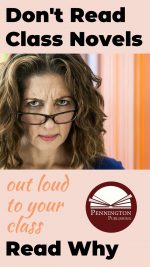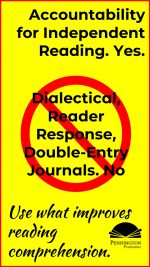Teach Content Reading
As a reading specialist, I’ve had the wonderful opportunity to coach elementary teachers in reading instruction and teach remedial reading at the middle school, high school, and community college levels. From this perspective, I’ve come to the conclusion that we teach too much reading at the elementary school level. Probably not the most popular position among my fellow reading specialists and literacy coaches, I know. But let me state my case and see if some of my colleagues would agree.
I currently teach seventh-grade English-language arts and an occasional reading intervention class in a large school district, outside of Sacramento, California. While serving in a prior position as a district reading specialist some twelve years ago, our district adopted Open Court® as our elementary K-6 reading program. Our district went “whole hog” after this program and we have achieved remarkable results in improving our elementary reading test scores. However, as has frequently been the case in the history of educational reform, initial success has its drawbacks.
As a reading specialist, we helped teachers implement a two-hour morning reading block with additional time, usually in the afternoons, for reading remediation. With state-mandated P.E. time, one hour of math, recess, and a thirty-minute lunch, this left but a few minutes a day for social studies, science, art/music, etc. Not to mention writing.
As we implemented Open Court®, reading specialists, literacy coaches, elementary teachers and their administrators tried to maintain the integrity of both the reading and math programs, while still teaching state-mandated social studies and science standards. After all, school district success is measured by test scores in these areas. And test scores drive curricular and instructional decision-making. The key buzzwords became “incorporate social studies (or science or arts or writing) instruction” into the two-hour “literacy block.” Code words for “ignore these content areas.” Reading instruction became reductive.
I’ve found this to be even more the case with middle school and high school reading intervention programs. Typically, replacing an English-language arts class or an elective with a remedial reading course reduces the amount of content area reading instruction.
With the district’s shift in instructional priorities, middle school teachers began noticing significant declines in “content-readiness” in the areas of social studies, science, and English-language arts in their Open Court®-trained students. Ironically, the über-emphasis on reading (particularly in decoding and fluency development) has minimized student practice with the thinking processes and content prior knowledge so necessary for more advanced “reading to learn” skills at the secondary levels. The academic language of social studies and science expository texts are truly wake-up calls for in-coming seventh-graders. The resulting declines in middle school test scores probably have more to due with lack of elementary preparedness (as described above) and more-challenging expository-based middle school tests than a lack of middle school teaching expertise or the middle-school concrete operational “bubble” described by many cognitive psychologists.
The de-emphasis of elementary writing instruction has ill-prepared students for both reading and writing informative and argumentative text or essays at the secondary level. Writing instruction directly impacts reading comprehension. What better way to teach the reading skills of main idea, support details/evidence/interpretation, and text structure, than through writing instruction? What little writing instruction there is seems devoted to churning out the four or five “writing application standards” at each grade level. These are full-process pieces, requiring even fourth-graders to complete multi-paragraph essays. Results can be appalling. Students know the form, but can’t write in complete sentences. Essay strategy development is non-existent. Spelling, grammar, and mechanics instruction is relegated to a ten-minute D.O.L. (Daily Oral Language) opener or as last-minute test practice.
My solution is to allocate less direct instructional reading time at the elementary level and to minimize reduction of content area classes by requiring extensive, multi-year reading intervention programs for secondary students. Less is often better. We need to trust our content area colleagues to teach reading. Let’s revive the every teacher, a teacher of reading mindset. Additionally, we need to develop more flexible delivery methods than those advocated, say in current Response to Intervention models. Many of these models are advocating two and one-half hours of direct reading instruction. Where will it end? Teachers have to make a basic commitment to differentiate instruction and receive extensive training to teach reading efficiently. Administrators and district leaders need to support more balanced instruction, irrespective of possible short-term test score dips to achieve long-term results. More time (and frequently more money) thrown at any subject of instruction, even a subject as important as reading, simply isn’t the answer.
Following is a great content area reading resource to help unify reading instruction at your school.
*****

The Science of Reading Intervention Program
The Science of Reading Intervention Program: Word Recognition includes explicit, scripted instruction and practice with the 5 Daily Google Slide Activities every reading intervention student needs: 1. Phonemic Awareness and Morphology 2. Blending, Segmenting, and Spelling 3. Sounds and Spellings (including handwriting) 4. Heart Words Practice 5. Sam and Friends Phonics Books (decodables). Plus, digital and printable sound wall cards and speech articulation songs. Print versions are available for all activities. First Half of the Year Program (55 minutes-per-day, 18 weeks)
The Science of Reading Intervention Program: Language Comprehension resources are designed for students who have completed the word recognition program or have demonstrated basic mastery of the alphabetic code and can read with some degree of fluency. The program features the 5 Weekly Language Comprehension Activities: 1. Background Knowledge Mentor Texts 2. Academic Language, Greek and Latin Morphology, Figures of Speech, Connotations, Multiple Meaning Words 3. Syntax in Reading 4. Reading Comprehension Strategies 5. Literacy Knowledge (Narrative and Expository). Second Half of the Year Program (30 minutes-per-day, 18 weeks)
The Science of Reading Intervention Program: Assessment-based Instruction provides diagnostically-based “second chance” instructional resources. The program includes 13 comprehensive assessments and matching instructional resources to fill in the yet-to-be-mastered gaps in phonemic awareness, alphabetic awareness, phonics, fluency (with YouTube modeled readings), Heart Words and Phonics Games, spelling patterns, grammar, usage, and mechanics, syllabication and morphology, executive function shills. Second Half of the Year Program (25 minutes-per-day, 18 weeks)
The Science of Reading Intervention Program BUNDLE includes all 3 program components for the comprehensive, state-of-the-art (and science) grades 4-adult full-year program. Scripted, easy-to-teach, no prep, no need for time-consuming (albeit valuable) LETRS training or O-G certification… Learn as you teach and get results NOW for your students. Print to speech with plenty of speech to print instructional components.
SCIENCE OF READING INTERVENTION PROGRAM RESOURCES HERE for detailed product description and sample lessons.
Get the SCRIP Comprehension Strategies FREE Resource:
![]()
Literacy Centers, Reading, Spelling/Vocabulary, Study Skills, Writing








